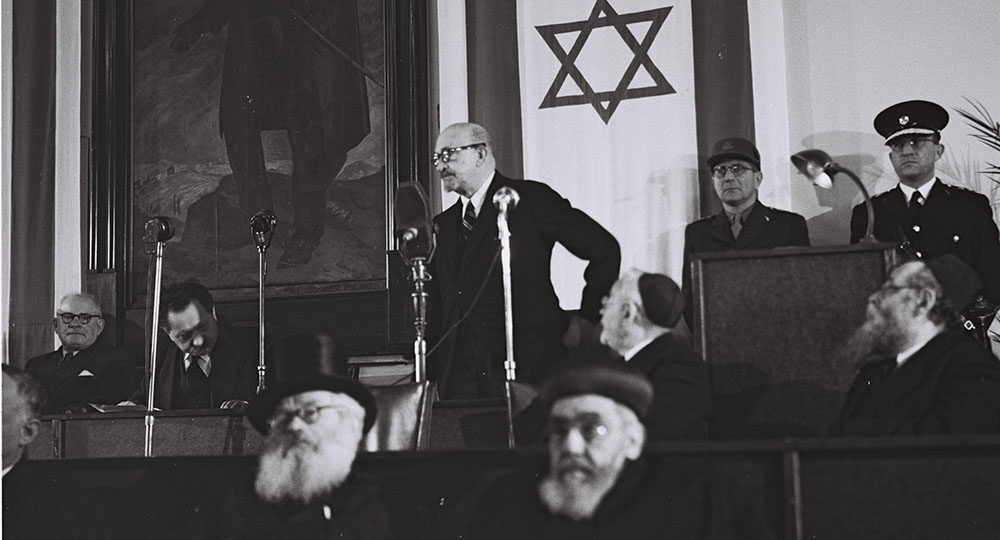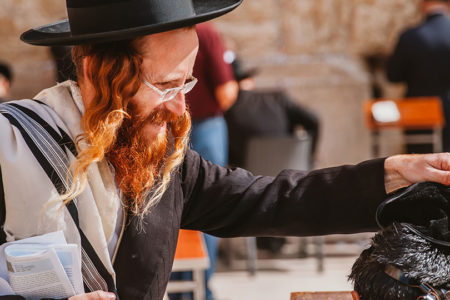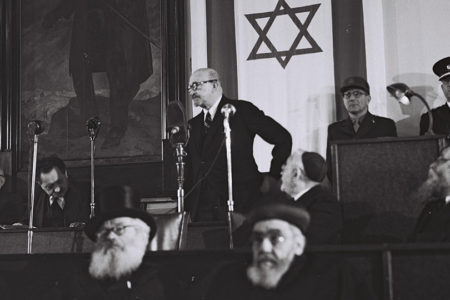Israel’s Broken Political System
Many Americans scratch their heads trying to figure out Israel’s political system. So we asked our friend Elliot Jager, a Jewish resident of Jerusalem and an American-Israeli with a PhD in political science from New York University, to explain how it works.
When my wife, Lisa, and I voted in the Jerusalem municipal elections last year, four candidates were running for mayor. Since no one garnered 40 percent of the vote, a runoff was held in November. Veteran politician Moshe Lion defeated young reformer Ofer Berkovitch.
The election was atypical because we voted for a person. In national elections, Israelis choose a party, not an individual. The more votes the party slate of 120 names receives, the more seats it wins in the 120-seat Knesset, Israel’s parliament.
Lisa and I also voted for the Jerusalem municipal council. As with national elections, we selected one party’s slate from more than a dozen. The more votes a slate receives, the more seats it wins on the 31-member city council.
When the Jerusalem municipal council votes were counted, roughly 20 of the 31 seats went to Orthodox or theologically right-leaning parties. Though Mayor Lion received more than 100,000 votes, the slate he headed did not win a single seat. So in return for city council support, he likely had to divvy up lots of patronage in the form of jobs and budgetary funding.
No city council or Knesset member represents my neighborhood because council members, like Knesset members, are elected at large. There are no districts, no constituencies. Interest groups are represented, yet no one is personally accountable to the voters. I have no elected official I can turn to, for example, to get a traffic light installed on a dangerous corner near my home. And the clout the Orthodox wield at the national level is disproportionate. Merely 22 percent of Israel’s population is Orthodox and ultra-Orthodox. Yet these parties are pivotal in forming most Israeli governments.
When groups with relatively small followings are overrepresented, the process of governing is undermined. Having so many groups in government is what political scientists call hyperpluralism. In my opinion, the rules of the political game need to be changed. Israel’s proportional electoral method needs to be ditched for a scheme closer to the American or British model.
Origins
Israel’s War of Independence was still raging when on July 8, 1948, less than two months after the country declared independence, the pre-state constituent assembly created an election committee chaired by David Bar-Rav-Hai of the Mapai Party. Mapai became the dominant component of Israel’s Labor Party. Bar-Rav-Hai’s task was to come up with a blueprint for Israeli democracy.
IT IS NO DREAM
Read more about Israel’s struggle for independence in It Is No Dream by Elwood McQuaid.
Some committee members favored creating electoral districts, as in the United States or Britain, where members of Congress or the House of Commons represent geographical areas, and voters can turn to them for services. However, the committee nixed constituency representation, thinking Israel’s method offered the best chance for marginal and single-issue groups to gain representation. It is also the best way to ensure that no one is disenfranchised.
So no one represents Herzliya or Tel Aviv or Jerusalem in the Knesset. Moreover, within those cities, municipal council members do not represent specific neighborhoods. Israel’s founders, led by David Ben-Gurion, also agreed anyone age 18 or older could vote, and the national legislature should have 120 seats.
When the war was almost over, Israel held its first election on January 25, 1949, for the Constituent Assembly. A political party needed merely 1 percent of the vote to cross the threshold. Today, the qualifying threshold is 3.25 percent, though Prime Minister Benjamin Netanyahu floated the idea of lowering the electoral threshold to 2 percent. Mathematically, a slate that wins 3.35 percent of the total vote in the anticipated 2019 elections would earn about four seats in the Knesset. The more votes, the more seats.
Permanent Minority Government
From 1949 until now, no party has ever won a Knesset majority of 61 seats. Every government has been a cobbled-together coalition. Usually, the president calls on the leader of the party holding a plurality of votes to form a government. The leader then bargains with others whose parties have made it into the Knesset, offering them patronage, ministries, and other incentives to join them in government.
In 1949, social-democratic Mapai garnered 46 seats; so its leader, David Ben-Gurion, turned to the United Religious Front (an amalgamation of Orthodox parties) that had 16 seats to build a coalition of 62 seats. To cushion his majority, he brought in the liberal Progressive Party, which had five seats, and the Sephardim and Oriental Communities Party, with its four seats. That gave Ben-Gurion 71 seats. He also invited an Arab party affiliated with his Mapai to join the government, adding two more places and giving him a final majority of 73 seats.
Ben-Gurion could have turned to several other parties, such as Mapam, a pro-Soviet workers party (Stalin did not publicly target Russian Jews until 1952), which held 19 seats. He also could have turned to Menachem Begin’s Herut Party and its 14 seats, but he wanted to exclude both Herut and Mapam from influence.
By October 1950, Ben-Gurion’s coalition had crumbled. New elections were held in July 1951. Again, Mapai won a plurality, and President Chaim Weizmann again asked Ben-Gurion to form the government. Meanwhile, on February 16, 1949, Israel’s legislative body, the Constituent Assembly, had passed the “Law of Transition” and transformed itself into the Knesset.
Cobbling Together a Government
The 2015 Knesset election was typical in that, again, no party won a majority. Benjamin Netanyahu’s Likud won 30 seats, while its main ideological opponent, the Zionist Union, won 24. In other words, 64 percent of Israel’s electorate did not support Netanyahu’s party.
For Netanyahu to govern, he needed to build on his Likud’s 30 seats to form a coalition of at least 61 seats. He turned to the Jewish Home Party (Orthodox, Zionist, supportive of settlements in Judea and Samaria), which had eight seats; Kulanu (center-right, attracts disaffected Likud voters), 10 seats; United Torah Judaism (ultra-Orthodox, European heritage, non-Zionists), six seats; Shas (ultra-Orthodox, Sephardi of North African heritage), seven seats; and belatedly to Yisrael Beiteinu (nationalist, secular, mostly Russian-speakers), five seats. (It started with six seats, but one of its members broke away.) This gave Netanyahu 66 seats. Another election was scheduled for April 2019, after this magazine goes to press.
Netanyahu—like all his predecessors—had to cut deals in return for support. When the dust settled, his coalition was comprised of parties with significant religious and political differences, pulling him in opposite directions, which explains why it’s hard to get things done in Israel.
For example, Netanyahu’s United Torah Judaism partner wants to enshrine draft deferments for ultra-Orthodox youths. His Yisrael Beiteinu partner sees no reason why these young men should not serve their country. Netanyahu gave the Jewish Home Party the Diaspora portfolio, making it responsible for relations with Jewish people abroad. However, this Orthodox party considers Reform and Conservative Judaism inferior, even though most Jews in the United States identify religiously with these progressive streams. Netanyahu regularly promises Reform and Conservative leaders visiting Israel that he will reduce discrimination against them (at the Western Wall complex, for instance) but invariably reverses himself under pressure from his Orthodox coalition partners. He has repeatedly reneged on his promise to allow surrogate births for homosexual couples. Kulanu, which supports same-sex surrogacy, votes with the ultra-Orthodox opponents of gay rights simply to preserve the Netanyahu coalition.
Fifty-six percent of Israelis—including those on the right—favor same-sex surrogacy, but parties representing the 12 percent ultra-Orthodox minority can dig in their heels, rather than compromise.
Though Netanyahu may be the chef, he has to share the kitchen with too many cooks. The dishes they concoct can sometimes turn the stomach.
Encouraging Moderation
To fix the problems caused by hyperpluralism, the rules of the political game must change. Israel’s proportional electoral method needs to be exchanged for something closer to the American or British model.
In Israel, if you garner only 3.25 percent of the vote, you “win a little.” Politicians have more incentive to frame public policy along doctrinal, rather than pragmatic, lines. In contrast, a winner-take-all electoral system is supposed to discourage narrow, single-issue, or radical candidates or immoderate parties that cater to only a sliver of the population.
Today, however, the notion that a winner-take-all electoral system discourages extremism has become shaky. Americans are viscerally divided over Donald Trump’s presidency. Nonetheless, if they elected their representatives using Israel’s political system, fanatics festering at either extreme of the political spectrum would have far more clout.
Constitution
Students of the Arab-Israeli conflict recall that United Nations General Assembly Resolution 181 of November 29, 1947, best known as the Partition Plan, called for the division of British Mandate Palestine into one Arab and one Jewish state living side-by-side in peace. The Arabs rejected the Partition Plan, and war ensued.
What many people may not know is that the plan also required the Arab and Jewish states to draft democratic constitutions. With that in mind, the Israel Declaration of Independence promised a constitution would be adopted no later than October 1, 1948. David Ben-Gurion invested some effort in a draft constitution, but the (Orthodox Zionist) Mizrahi Party and the ultra-Orthodox parties rejected any document not anchored in the Shulchan Aruch, or Code of Jewish religious law (a 1563 compendium that even its author did not mean to be the final word).
Ben-Gurion quickly lost his enthusiasm for a constitution. In his book Ben-Gurion: A State at All Costs (available in English this summer), historian Tom Segev maintains Ben-Gurion never wanted a constitution. That may be so because his Mapai Party was dependent on the Orthodox to retain power. As a workaround, he agreed in 1950 to what became known as the Harari compromise: Israel’s constitution would be built chapter by chapter through separate “Basic Laws.” Eight years later, the Knesset enacted the first Basic Law. With 11 Basic Laws to date, Israel’s constitution remains a work in progress.
The downside of this system is that a Basic Law can be amended by a simple majority—61 of the 120 Knesset members—making it relatively easy to change Israel’s “constitution” and cater to the passions of the moment. And that is precisely why the framers of the U.S. Constitution designed an obstacle-filled amendment process: to make it hard to abruptly change the rules of the political game.
If and when Israel’s politicians ever get serious about completing the country’s constitution, the Israel Democracy Institute, a good-government think-tank with the input of experts from across Israel’s political and theological spectrum, has crafted a “consensus” constitution to get the ball rolling.
Checks and Balances
While Israel has no constitution, the Office of the Attorney General (AG) and the Supreme Court make it difficult for a runaway Knesset majority to trample civil liberties, tolerance, the rule of law, and respect for human rights. The AG has evolved into perhaps the second most powerful institution in the country. On paper, it serves as the lawyer of the sitting government. It also directs the State Prosecutor’s Office and supervises a bureau that reviews proposed legislation to ensure bills are in harmony with Basic Laws, societal values, and even international law.
These responsibilities give Attorney General Avichai Mandelblit a say in virtually any public legal matter. The AG sits atop a network of deputies ensconced in almost every government ministry, including finance, justice, and defense. To undermine this watchdog function, the Jewish Home Party has proposed legislation that would give ministers control over the deputy AGs assigned to their fiefdoms. The party and others on the populist right are irked because not much can happen if the AG opposes an issue. Thus, even if an overwhelming majority of Knesset members wanted to pass a bill that required citizens to wear red suspenders on Mondays, the AG could block it.
The ultimate check on Israel’s hyperpluralist political system is the Supreme Court. It consists of 15 justices appointed by a judicial selection committee that includes representatives from the court itself, Bar Association, prime minister’s government, and Knesset. The current chief justice is Esther Hayut.
Israel’s Supreme Court rules as a court of original jurisdiction in matters regarding the legality of state decisions. It can grant relief against government actions “in the interests of justice.” In 1995, under Chief Justice Aharon Barak, the court decided Basic Laws have supremacy over lesser Knesset laws, and it gave itself the power of judicial review—much as the U.S. Supreme Court in 1803 gave itself the power of judicial review in Marbury v. Madison.
The Israel Supreme Court also has appellate jurisdiction over criminal, civil, and military court judgments and other decisions of the District Courts.
The Israeli justices need to be workaholics. Whereas the U.S. Supreme Court generally hears fewer than 100 cases a year, Israel’s Supreme Court has an annual caseload that can easily top 3,000. In the United States, a petitioner must show that an issue directly affects him before he can go before the court. Israel’s requirements are less stringent. The court is magnanimous in allowing petitioners access to its bench.
Prospects for Electoral Reform
For those who concur Israel’s political system needs revamping, there is scant reason for optimism. Parochial parties will not give up their disproportionate influence without a fight. Electoral reform will remain a bridge-too-far unless the major parties temporarily bury their differences. And without changing how the Knesset is elected, there is little prospect for framing a constitution.
Over the years, scholars have proposed all sorts of reform options; and politicians say they want reform. In a November 5, 2015, Knesset speech, Netanyahu promised to lead the way on overhauling the political system. Yair Lapid’s Yesh Atid Party favors restructuring the system. Yisrael Beiteinu’s Avigdor Lieberman put electoral reform at the top of his agenda.
In 1992, Israelis had a chance to elect the prime minister directly, though the method of choosing Knesset members went unchanged. It was under this system that Netanyahu was elected for the first time in 1996 and defeated by Ehud Barak in 1999. In February 2001, Ariel Sharon overcame Barak. However, direct election of the prime minister was widely deemed a failure and was reversed.
Another approach might be to reempower Israelis to elect the prime minister directly and to elect Knesset members along district lines. A variation on this theme would see half of the Knesset elected along district lines and the other along the present proportional system.
That said, there are principled stalwarts of the current system—not merely those who benefit politically from the power of small parties. “There is a reason the founding fathers decided that the electoral threshold should be low,” said Reuven Rivlin after he had left the Knesset speaker’s post but before being elected Israel’s president in 2014. “The logic was to allow as many opinions and stances in Israeli society as possible to be represented in the Knesset since we are so varied and divided. The Knesset prevented civil wars in the past because of its ability to represent all of the opinions in the nation, and we must preserve that.”
The question is whether what was intended to work for Israel 70 years ago still makes sense today.








